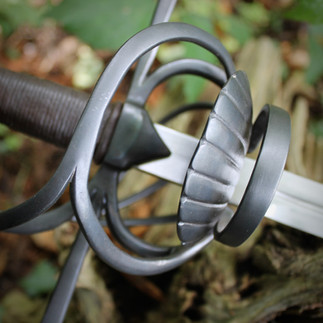The Finisterra Rapier
- Alicia Adams
- Aug 9, 2023
- 3 min read
Updated: Apr 3, 2024

This intuitive rapier is based on an amalgam of originals from the 16th-17th Centuries housed in the Stibbert Collection. Made by Chris to test out a historical forging pattern, it employs traditional methods to create the structure of the quillons and rings.
Supremely willing, it employs a hollow pommel and a slender blade for a nice neutral feel, though it still has presence in the hand, offering feedback throughout the fight and holding the line with ease.
Strikingly, the guard features a hand-carved scallop shell guard, resting between the rings. This offers increased hand protection, as well as a bit of period flair. The scallop shell has been used for centuries as a symbol of the Camino de Santiago pilgrimage, and the Camino Finisterre that follows on from it. The rapier takes its name from this association.
Please see our pricing structure for what a similar custom sword would cost.
∴ Specs ∴

Total length: 121cm
Blade length: 107cm
Blade width at shoulder: 2.2cm
Blade stock: 6mm
Quillon span: 22cm
Grip length: 7cm
Grip and pommel: 11.5cm
Grip to guard space: 5cm
Point of balance: 14cm
Weight: 995g
Right-handed
Blunt edges and swollen tip
Fencing safe flex
Built for a palm size of 8.5 - 9 cm
∴ Notes ∴

The hand-forged and heat-treated guard and pommel are blackened to a matte finish.
The guard features a hand-carved scallop plate resting in the port, with straight flat quillons and a sweeping counterguard. The pommel is hollow, and hand-carved with a swirling motif.
The oak grip is wrapped first in linen thread, then in brown kidskin.
The blade features one central fuller to the forte.
∴ Gallery ∴
∴ A Journey's End∴

“One foot in front of the other,” you think to yourself for the umpteenth time today. The simple mantra has become akin to a prayer as you stumbled over cracked, dusty stone, over rolling hills and through rocky crevasses. Where your companions have their rosaries and their psalters, you have faith in your own two feet. And, of course, you have the sword.
You have carried the sword a long way now, slung about your waist on rough leather straps. You have become accustomed to the feel of its black scallop hilt swinging at your hip, and adjusted your gait to account for its narrow blade slapping at the back of your knee. Light as it feels in the hand, its weight has certainly slowed your once-manic pace over the weeks.
Your fellow pilgrims eyed it with suspicion. You have been asked why you carry it, received well-meant offers to share the load, and been berated for not laying down your earthly possessions, as the Disciples did. All you can do is smile sadly in response and keep walking: one foot in front of the other.
And now it is visible in the distance: the hazy horizon between sea and sky, and the indistinct peninsula of grey rock jutting toward it. Finisterra. The End of the World. And so it was when he died at war, sword in hand, a loyal soldier to the last. You did not leave your garret for weeks, did not eat or sleep, as unable to bear the sorrow as you were to share it: that unspeakable love you had known.
“I will love you to the ends of the earth,” you told him before he left, and you have held true to your word. After a month of blistered feet, baking sun and gradual, gruelling rebecoming, you have reached Finisterra.
It was the sword that inspired it: delivered to you by a messenger boy some weeks after his death, according to his final wish. You had stared dumbly at it, turning it over and over in your hands, memorising every line carved into its swirling pommel, its seashell guard. The shell had always made you think of the pilgrims, passing through on their way to Santiago. And in that mundane little thought, you felt something like solace. Something like yourself.
Turning briefly to be sure you are alone, you scramble down the crumbling sandstone rocks toward the sea, the wind catching your hair and tugging at your doublet, as if willing you into the waves yourself. You think about it for a moment, as you have many times over the course of your journey. You let the sharp tang of desolation draw you in for a moment, so familiar as to be almost comforting.
Then, instead, you crouch to the ground and unhook the sword from your belt, pressing your lips to the waves of its pommel, and laying it at last to rest on a sea-slick stone at the end of all things.












